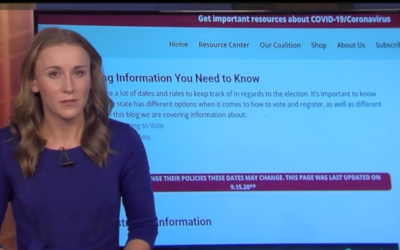Misinformation and Disinformation
Misinformation, disinformation and dirty tricks have been used to scare and mislead voters for as long as there have been elections. 2020 has been a year like no other as last-minute disinformation overwhelms voters in a chaotic and contentious election.
In the third episode of the #SignVote Series: Election-Related Misinformation & Disinformation, learn how to flag inaccurate information and where to look for reliable sources. We are encouraging voters to get their information from trusted sources, such as secretaries of state or local election offices.
Stay tuned for more episodes this week!
Special thanks to ASLized, National Association of the Deaf – NAD, and The Center for Democracy in Deaf America.
[TRANSCRIPT with visual descriptions: Video with text being typed: How to identify Misinformation and Disinformation. SignVote logo appears before transitioning to Kriston Pumphrey, a dark tanned mid-thirties gentleman with short trimmed salt and peppered beard wearing a black sweater in front of an animated background. As the video progresses, graphics appear on screen to support his message. Kriston’s message is in American Sign Language and accompanied by voiceover.]
In the past 15 years, we have seen an increasing shift in how we absorb information online. This is nothing new for our deaf community. We have always been on the lookout for new technology and innovation, especially in terms of how we connect and communicate within our community.
Before we go deeper into this subject, there are a few important things you should keep in mind. First of all, this trend of receiving information from the internet is actually a global phenomenon. This means that political information is seriously affected both inside and outside of the U.S.
Secondly, we are currently in the midst of a pandemic. More and more people are staying home and surfing the internet. We are trying to find information about the virus, such as dealing with the pandemic, our response to the crisis, and individual actions we should take, such as social distancing, washing our hands, wearing a mask, etc. There is so much information constantly thrown at us. It’s important to make sure that the information you receive is reliable.
It’s important to remember that, yes, there are many accurate and believable sources, but there is also a lot of misinformation and disinformation. The dictionary defines ‘misinformation’ as “false information that is spread regardless of intent to mislead.” Really any kind of wrong or false information that is incorrectly shared. Whereas ‘disinformation’ is intended to mislead.
Using personal beliefs or views to manipulate information or facts to shift narratives and knowingly spreading misinformation.
Why is false information being spread? Some of it is related to special interest groups with money tied to different political groups that advocate for things like guns and other issues. They either want to cause confusion and fear. Or the individual responsible for spreading false information might be confused or scared and resistant to change. Other possible reasons are that people from different countries outside of the U.S. want to see our democracy and government system fail. They want to use false information to create confusion and manipulate you in a way that suits their goals.
Let’s talk about how you can find credible and reliable information. Across social media, you might have seen the same information reposted or reshared over and over again. Don’t immediately believe all the graphics, screenshots, and memes you see. Before you start sharing all of the things you see circulating on social media, hit the pause button. Check out the information that is being shared. Ask yourself a few simple questions: Who is this information coming from? An individual, an organization, or a news entity?
If you see a person while on social media, keep an eye out for people who are responsible for sharing information about the voting process. A reliable source is someone who represents the government, like the spokesperson for the Secretary of State (SOS). They tend to have this responsibility in each state. There are many people commenting on the election, but if those people’s accounts aren’t verified, it’s better to look for a verified SOS representative for accurate information.
If it’s an organization, is it on behalf of the government or a nonprofit organization formally recognized by the US government and is it their official account? Is it actually shared from their verified account or simply a screenshot? If it’s a screenshot, try finding the original post. If it does not exist, don’t immediately believe the information. Organizations like CSD and NAD help provide our deaf community with voting information. It’s always helpful to double-check information with formal government websites. If the information matches, it’s credible.
If the information is coming from a news organization, you must research their history. How long has the organization been around? Suppose it is hard to find information about their history. In that case, it’s possible that the news organization was set up quickly to spread false, misleading, or inaccurate information to convince you that it is real news when it really isn’t.
Now regarding websites, it’s important to look at the last part of the web address or URL. For example, .gov is used for official government websites. .org is typically used for organizations, but in August 2019, the rules changed. Now anyone can apply for a .org web address, not just nonprofits. .edu is used for educational institutions such as universities and colleges, which are good sources for credible and reliable information. .com is a broader URL with a different set of rules and processes that are generally more flexible than the others. I encourage you to do your research on these websites and make sure that their information is accurate and credible.
Did you know that there are different types of news organizations? Some have more right-leaning views; others have more left-leaning views. But are they trustworthy? For example, instead of Fox News or MSNBC, I recommend that you look at a list of trusted, credible, and neutral news organizations that have been around for a long time. For example, AP News, C-Span, Reuters, and NPR are considered the most credible news organizations. There are others, such as the New York Times, the Washington Post, and The Wall Street Journal.
You know, over the next several months, there will be a lot of confusing information circulating out there. The most important thing you must remember that your right to vote is exactly that – your right. Don’t let any confusion rob you of your right. Always double check your election information and make sure that you plan ahead before you vote. That way, you will feel confident and secure, knowing that you have the right information and are prepared to vote.
[Video ends with a SignVote logo and credit roll. Screen fades to black. Video ends.]
[TRANSCRIPCIÓN con descripciones visuales: Video con texto mecanografiado: Cómo identificar la información errónea y desinformación. El logotipo de SignVote aparece antes de hacer la transición a Kriston Pumphrey, un caballero bronceado de mediados de los treinta años con una barba corta y moteada, lleva un suéter negro frente a un fondo animado. A medida que avanza el video, aparecen gráficos en la pantalla para respaldar su mensaje. El mensaje de Kriston está en lenguaje de señas americano y está acompañado de una voz en off.]
En los últimos 15 años, hemos visto un cambio creciente en la forma en que absorbemos la información en línea. Esto no es nada nuevo para nuestra comunidad de sordos. Siempre hemos estado buscando nuevas tecnologías e innovación, especialmente en términos de cómo nos conectamos y nos comunicamos dentro de nuestra comunidad.
Antes de profundizar en este tema, hay algunas cosas importantes que debe tener en cuenta. En primer lugar, esta tendencia a recibir información de internet es en realidad un fenómeno global. Esto significa que la información política se ve seriamente afectada tanto dentro como fuera de los Estados Unidos.
En segundo lugar, actualmente nos encontramos en medio de una pandemia. Cada vez más y más personas se quedan en casa y navegan por el internet. Estamos tratando de encontrar información sobre el virus, de cómo lidiar con la pandemia, nuestra respuesta a la crisis, y las acciones individuales que debemos tomar, como el distanciamiento social, lavarnos las manos, usar una mascarilla, etc. Hay mucha información constantemente arrojada a nosotros. Es importante asegurarse de que la información que se recibe sea confiable.
Es importante recordar que, sí, hay muchas fuentes precisas y creíbles, pero también hay mucha información errónea y desinformación. El diccionario define “información errónea” como “Información falsa que se difunde independientemente de la intención de inducir a un error”. Realmente cualquier tipo de información incorrecta o falsa que se comparta incorrectamente. Mientras que la “desinformación” pretende inducir a un error. Usando creencias o puntos de vista personales para manipular información o hechos para cambiar las narrativas y difundir información errónea a sabiendas.
¿Por qué se difunde información falsa? Parte de ella está relacionada con grupos de intereses especiales con dinero vinculado a diferentes grupos políticos que abogan por cosas como armas y otros temas. O quieren causar confusión y miedo. O el individuo responsable de difundir información falsa puede estar confundido o asustado y resistirse al cambio. Otras posibles razones son que personas de diferentes países fuera de los Estados Unidos quieren ver que nuestra democracia y nuestro sistema de gobierno fracasen. Quieren usar información falsa para crear confusión y manipularla de una manera que se adapte a sus objetivos.
Hablemos de cómo puede encontrar información creíble y confiable. En las redes sociales, es posible que haya visto la misma información publicada o compartida una y otra vez. No crea inmediatamente todos los gráficos, las capturas de pantalla y memes que ve. Antes de comenzar a compartir todas las cosas que ve circulando en las redes sociales, presione el botón de pausa. Revise la información que se comparte. Hágase algunas preguntas simples: ¿De quién proviene esta información? ¿Un individuo, una organización o una entidad de noticias?
Si ve a una persona en las redes sociales, esté atento a las personas que son responsables de compartir información sobre el proceso de votación. Una fuente confiable es alguien que representa al gobierno, como el portavoz de la Secretaría del Estado (SOS). Suelen tener esta responsabilidad en cada estado. Hay muchas personas que comentan sobre las elecciones, pero si las cuentas de esas personas no se verifican, es mejor buscar un representante de la SOS verificado para obtener información precisa.
Si es una organización, ¿es en nombre del gobierno o es una organización sin fines de lucro reconocida formalmente por el gobierno de los Estados Unidos y es su cuenta oficial? ¿Es realmente compartido desde su cuenta verificada o simplemente una captura de pantalla? Si es una captura de pantalla, intenta buscar la publicación original. Si no la puede encontrar, no crea inmediatamente en la información. Organizaciones como Servicio de comunicación para sordos (CSD) y la Asociación Nacional de Sordos (NAD) ayudan a proporcionar a nuestra comunidad de sordos información para votar. Siempre es útil verificar la información con sitios web gubernamentales formales. Si la información coincide, es creíble.
Si la información proviene de una organización de noticias, debe investigar su historial. ¿Cuánto tiempo ha existido la organización? Suponga que es difícil encontrar información sobre su historia. En ese caso, es posible que la organización de noticias se haya creado rápidamente para difundir información falsa, engañosa o inexacta para convencerlo de que se trata de una noticia real cuando en realidad no lo es.
Ahora, con respecto a los sitios web, es importante mirar la última parte de la dirección web o URL. Por ejemplo, .gov se utiliza para sitios web gubernamentales oficiales. .org se utiliza normalmente para organizaciones, pero en agosto del 2019, las reglas cambiaron. Ahora cualquiera puede solicitar una dirección web .org, no solo las organizaciones sin fines de lucro. .edu se utiliza para instituciones educativas como universidades y colegios, que son buenas fuentes de información creíble y confiable. .com es una URL más amplia con un conjunto de reglas y procesos que generalmente son más flexibles que los demás. Le animo a que investigue en estos sitios web y se asegure de que su información sea precisa y creíble.
¿Sabías que existen diferentes tipos de organizaciones de noticias? Algunas tienen opiniones más derechistas; otros tienen puntos de vista más izquierdistas. ¿Pero son dignos de confianza? Por ejemplo, en lugar de Fox News o MSNBC, le recomiendo que consulte una lista de organizaciones de noticias confiables, creíbles y neutrales que han existido durante mucho tiempo. Por ejemplo, AP News, C-Span, Reuters y NPR se consideran las organizaciones de noticias más creíbles. Hay otros, como el New York Times, el Washington Post y The Wall Street Journal.
Sabes, durante los próximos meses, habrá mucha información confusa circulando por ahí. Lo más importante que debe recordar es que su derecho a votar es exactamente eso – su derecho. No deje que ninguna confusión le robe su derecho. Siempre verifique dos veces la información de su elección y asegúrese de planificar con anticipación antes de votar. De esa manera, se sentirá confiado y seguro, sabiendo que tiene la información correcta y está preparado para votar.
[El video termina con un logotipo de SignVote y una lista de créditos. La pantalla se vuelve negra. El video termina.]




